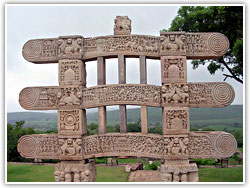|
|
Sanchi, Madhya Pradesh
.............................................................................................................................................................................. |
|
Information about Sanchi
Sanchi is an important Buddhist pilgrimage center
of India. Sanchi is situated about 68 km. north of
Bhopal on a hill rising from the plains. This hill
is topped by some of the oldest and most
interesting Buddhist shrines in the country. The
imposing hilltop site offers commanding views of
the surrounding countryside. Sanchi is a peaceful
town crowned by a group of stupas and abandoned
monasteries that are one of the most important
Buddhist sites in India. Sanchi is |
 |
|
|
known for the famous stupa,
built by the Emperor Ashoka.
History of Sanchi
Sanchi had no direct connections with the life of Lord
Buddha. It was a centre of Hinayana (the “Lesser
Vehicle”) of Buddhism. But, the Buddha’s greatest
disciple Emperor Ashoka came here and built the first
stupa in the third century B.C. During the succeeding
years, a great number of other stupas and Buddhist
buildings were added. With the decline of Buddhism, the
monuments of Sanchi were totally forgotten. It was only
through chance that Sanchi was re-discovered in 1818 by
a British officer, General Taylor. During the following
years, amateur archaeologists and greedy treasure
hunters did great damage to the monuments. The Ashoka
Pillar was used to build a sugarcane press. Between 1912
and 1919, the structures were carefully repaired and
restored through the efforts of an archaeologist and
historian, Sir George Marshal.
Tourist Attractions in Sanchi
The main tourist attraction in Sanchi is the Great Stupa.
Besides this stupa, Sanchi has various other stupas and
ruins of several Buddhist temples and monasteries. |
|
|
|
The Great Stupa
The Great Stupa at Sanchi was originally built by
Ashoka in the third century B.C. The Great Stupa
was later enlarged. The original brick stupa was
enclosed within a stone one. At present it stands
16 metres high and 37 metres in diameter. A
balcony, walkway and railing encircles the Stupa.
After 75 years, the four magnificently carved
gateways or Toranas were built. These Toranas are
among the finest works of Buddhist art in India.
In 450 AD, four images |
 |
|
|
of the
Buddha (belonging to the later period) were placed
facing each of the four gateways. The four gateways were
erected around 35 B.C. They fell down during
restoration. The scenes carved on the pillars are from
the Jataka Tales, about the previous lives of Lord
Buddha and events in the subsequent history of Buddhism.
There were legends concerning the Buddha’s previous
lives before he was reincarnated as Siddhartha, Gautama
the Buddha. The gateways have been so finely carved and
with such inspiration that they are regarded as the
finest of all Buddhist toranas. The northern gateway is
the best preserved. At that time, the Buddha was not
worshipped in human form. His presence was often
indicated by the Bodhi tree or his footsteps. Some of
the interesting scenes from Buddha’s life like ascending
a road into the air and a monkey offering a bowl of
honey to Buddha are shown on the gateway. Elephants in
four directions support the architraves above the
columns while horses with riders and elephants fill the
gaps between the architraves. Buddha’s life and
teachings are conveyed through symbols in early Buddhist
art. Various pillars are scattered around the side of
stupa. The most important among these is Pillar No. 10
which was erected by Ashoka and stands close to the
south entrance of the stupa. Only the base of this
beautifully proportioned shaft stands now. The three
back-to-back lions which once topped the column are a
good example of Greek-Buddhist art of that period. They
now form part of India’s national emblem and can be seen
on every bank-note. There are a few more interesting
pillars which can be seen here.
Other Stupas
The various other stupas in Sanchi are the Stupa II and
Stupa III. Stupa II is one of the most interesting of
the lesser Stupas. There are no gateways here but the
medallions which decorate the surrounding walls are
interesting. Flowers, animals, people and some
mythological creatures adorn the walls. Stupa III stands
in the north-east of the Great Stupa. It has only one
gateway. It is smaller in size and similar in design to
the Great Stupa. It is believed that this Stupa was
built soon after the Great Stupa was constructed.
Excursion from Sanchi
Vidisha
Vidisha is situated about 10 km from Sanchi where
Emperor Ashoka ruled as a viceroy. This place belongs to
the 2nd century B.C. The Hindu shrine shows bricks
cemented together with lime mortar, the earliest known
use of cement. The Heliodorus Pillar nearby, was erected
in 140 B.C. by a Greek who embraced the Hindu religion.
Udaypur Caves
Udaypur Caves is situated about 90 km from Sanchi and
has colossal 11th century temple of Neelkanteshwar.
How to reach Sanchi
By Air:
The nearest airport is located in Bhopal, about 46 km
from Sanchi.
By Rail:
The railway station of Sanchi is located on the Central
Railway.
By Road:
Sanchi is connected by road with Indore, Bhopal, Gwalior
and other places. |
|